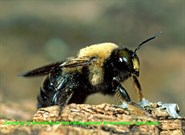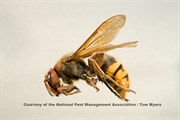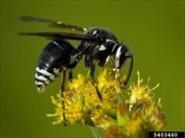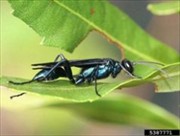Courtesy of our friends at NatGeo . . .
Dave's Pest Control
1-800-400-6009
A Central Massachusetts Extermination and Pest Control
Company
Worcester County Pest and Rodent Exterminators
www.davespestcontrol.net
July 30, 2012
July 28, 2012
The Buzz On Mosquitoes
One of the best known summer pests, mosquitoes breed in stagnant water or soft soil and can develop from egg to adult in 10 to 14 days.
Female mosquitoes suck our blood. Male mosquitoes feed on plant nectars. They can develop from egg to adult in 10 to 14 days. They are most active from dusk to dawn and will fly up to 14 miles for a blood meal.
Mosquitoes breed in stagnant water sources such as storm drains, old tires, children's wading pools and birdbaths, and are well-known to spread diseases such as West Nile Virus, malaria and dengue fever.
If you're concerned about mosquitoes around your home or place of business, give Dave a call at 1-800-400-6009.
Dave's Pest Control 1-800-400-6009
A Central Massachusetts Extermination and Pest Control Company
Worcester County Pest and Rodent Exterminators
www.davespestcontrol.net
Female mosquitoes suck our blood. Male mosquitoes feed on plant nectars. They can develop from egg to adult in 10 to 14 days. They are most active from dusk to dawn and will fly up to 14 miles for a blood meal.
Mosquitoes breed in stagnant water sources such as storm drains, old tires, children's wading pools and birdbaths, and are well-known to spread diseases such as West Nile Virus, malaria and dengue fever.
If you're concerned about mosquitoes around your home or place of business, give Dave a call at 1-800-400-6009.
Dave's Pest Control 1-800-400-6009
A Central Massachusetts Extermination and Pest Control Company
Worcester County Pest and Rodent Exterminators
www.davespestcontrol.net
July 26, 2012
Flea Protection For All
 Fleas aren’t just a problem for man’s best friend. These pests, which commonly appear in warmer months, feed on the blood of any warm-blooded body. Typically biting human beings, fleas can cause itchy, unsightly marks as well as severe allergic reactions.
Fleas aren’t just a problem for man’s best friend. These pests, which commonly appear in warmer months, feed on the blood of any warm-blooded body. Typically biting human beings, fleas can cause itchy, unsightly marks as well as severe allergic reactions. Fleas tend to travel with mammals on the move, which can include not only you and your pet but also rodents. If you have a rodent problem in your home, fleas may be soon to follow.
If you suspect a flea infestation, be proactive in treating the problem and call Dave at 1-800-400-6009 to rid your home of fleas and to prevent future infestations.
Dave's Pest Control 1-800-400-6009
A Central Massachusetts Extermination and Pest Control Company
Worcester County Pest and Rodent Exterminators
www.davespestcontrol.net
Reference: www.pestworld.org
July 24, 2012
Need a Pest Inspection?
There are two simple ways to request a pest inspection from Dave's Pest Control. Visit our web site and fill out a "Request Inspection Form," or just give us a call at 1-800-400-6009.
Our mission is to set the standard of superior service in the Pest Management Industry that exceeds customers' expectations, and provides an enriching, fulfilling and rewarding environment for employees while supporting the community.
If you're concerned about insect or rodent infestations in your home or place of business, give Dave a call at 1-800-400-6009. Our family protecting your family since 1972.
Dave's Pest Control 1-800-400-6009
A Central Massachusetts Extermination and Pest Control Company
Worcester County Pest and Rodent Exterminators
www.davespestcontrol.net
Our mission is to set the standard of superior service in the Pest Management Industry that exceeds customers' expectations, and provides an enriching, fulfilling and rewarding environment for employees while supporting the community.
If you're concerned about insect or rodent infestations in your home or place of business, give Dave a call at 1-800-400-6009. Our family protecting your family since 1972.
Dave's Pest Control 1-800-400-6009
A Central Massachusetts Extermination and Pest Control Company
Worcester County Pest and Rodent Exterminators
www.davespestcontrol.net
July 22, 2012
Summer Pest Control Is Critical
The hot and humid days of summers are here, and so are the fleas, ticks, ants, bees, wasps, and hornets. That's why we offer our customers seasonal pest control plans.
Beware Stinging Insects! Aside from yellowjackets, wasps, and hornets, predators of the insect world (scorpions, spiders, centipedes, etc.) follow their prey into our homes during this increased activity. They enter through cracks, crevices, damaged areas around our doors, windows, eaves, weep holes, plumbing penetrations, electrical/utility connections, etc. They are not seeking us, but interaction between people and these "stinging" insects is inevitable when we share the same living space.
If you're concerned about the summer pests in your home or place of business, give Dave a call at 1-800-400-6009.
Dave's Pest Control
Serving Central Massachusetts
www.davespestcontrol.net
Beware Stinging Insects! Aside from yellowjackets, wasps, and hornets, predators of the insect world (scorpions, spiders, centipedes, etc.) follow their prey into our homes during this increased activity. They enter through cracks, crevices, damaged areas around our doors, windows, eaves, weep holes, plumbing penetrations, electrical/utility connections, etc. They are not seeking us, but interaction between people and these "stinging" insects is inevitable when we share the same living space.
If you're concerned about the summer pests in your home or place of business, give Dave a call at 1-800-400-6009.
Dave's Pest Control
Serving Central Massachusetts
www.davespestcontrol.net
July 20, 2012
How To Identify the Pest, the Nest and the Threat - Carpenter Bees
Carpenter bees are between 1/2 - 1 inch in size. They resemble bumble bees, but the top of their abdomen is largely bare and shiny.

The nest: Carpenter bees do not live in nests or colonies. They bore into wood, where they make galleries for rearing their young. Carpenter bees tend to prefer decaying or weathered wood to new or painted wood.
The threat: Carpenter bees are a serious property threat, and can cause structural damage over time if they are not eliminated. Male carpenter bees can be territorial and may hover in front of one’s face aggressively, but they have no stinger and these actions are merely for show. Female carpenter bees do have a potent sting, which is rarely used.
Dave's Pest Control
1-800-400-6009
A Central Massachusetts Extermination and Pest Control Company Worcester County Pest and Rodent Exterminators
www.davespestcontrol.net
The above information was provided by Missy Henriksen, Vice President of Public Affairs, NPMA Executive Director, Professional Pest Management Alliance.
Reference: www.pestworld.org
July 18, 2012
How To Identify the Pest, the Nest and the Threat - Honey Bees
The pest: Honey Bees . . .
The nest: Honey bees are social insects and live as colonies in hives, with mature colonies of 20,000 – 80,000 individuals.
The threat: Honey bees are not aggressive and do not search for something to attack. Instead, they are defensive and will attack only whatever seems to threaten the colony.
If you're concerned about honey bees in your home or place of business, give Dave a call at 1-800-400-6009.
Dave's Pest Control
1-800-400-6009
A Central Massachusetts Extermination and Pest Control Company Worcester County Pest and Rodent Exterminators
www.davespestcontrol.net
The above information was provided by Missy Henriksen, Vice President of Public Affairs, NPMA Executive Director, Professional Pest Management Alliance.
Reference: www.pestworld.org
Honey bees are between 1/2–5/8
inch in size and orange-brown or black in color.
The nest: Honey bees are social insects and live as colonies in hives, with mature colonies of 20,000 – 80,000 individuals.
The threat: Honey bees are not aggressive and do not search for something to attack. Instead, they are defensive and will attack only whatever seems to threaten the colony.
If you're concerned about honey bees in your home or place of business, give Dave a call at 1-800-400-6009.
Dave's Pest Control
1-800-400-6009
A Central Massachusetts Extermination and Pest Control Company Worcester County Pest and Rodent Exterminators
www.davespestcontrol.net
The above information was provided by Missy Henriksen, Vice President of Public Affairs, NPMA Executive Director, Professional Pest Management Alliance.
Reference: www.pestworld.org
July 16, 2012
The Life Cycle of a Honey Bee
The life cycle of a honey bee is presented as an example of complete metamorphosis, the development of an insect from egg to larva, then pupa, then adult.
Moths, butterflies and wasps also develop with complete metamorphosis. Some aspects of beekeeping are also discussed.
If you're concerned about bees around your home or place of business, give Dave a call at 1-800-400-6009.
Dave's Pest Control
1-800-400-6009
A Central Massachusetts Extermination and Pest Control Company Worcester County Pest and Rodent Exterminators
www.davespestcontrol.net
Moths, butterflies and wasps also develop with complete metamorphosis. Some aspects of beekeeping are also discussed.
If you're concerned about bees around your home or place of business, give Dave a call at 1-800-400-6009.
Dave's Pest Control
1-800-400-6009
A Central Massachusetts Extermination and Pest Control Company Worcester County Pest and Rodent Exterminators
www.davespestcontrol.net
July 14, 2012
How To Identify the Pest, the Nest and the Threat - Yellowjackets
The Pest: Yellowjackets . . .
Yellowjackets have a yellow and black color pattern and are between 3/8 – 5/8 inches.
The nest: Yellowjackets live in nests constructed of paper carton, which can grow to be basketball-sized. One nest will contain a number of rounded paper combs, attached one below another and covered with a many-layered envelope. Depending on the species, the nest may be near the ground, such as on plant roots, logs or timber, or aerial and attached to shrubs, bushes, houses, garages or sheds.
The threat: Yellowjackets are slow to sting, unless their nests is threatened.Yellowjackets are considered beneficial insects because they control many pest insect species. However, if their nest is located near a structure, control is warranted.
Remember, it is not advised to attempt to remove a stinging insect nest on your own, and doing so can be extremely dangerous. Instead, work with a licensed pest professional to access your property and the nest to determine the best way to eliminate the threat to your family.
The above information was provided by Missy Henriksen, Vice President of Public Affairs, NPMA Executive Director, Professional Pest Management Alliance.
If you're concerned that you have yellowjackets around your home or place of business, give Dave a call at 1-800-400-6009.
Dave's Pest Control
1-800-400-6009
A Central Massachusetts Extermination and Pest Control Company Worcester County Pest and Rodent Exterminators
www.davespestcontrol.net
Reference: www.pestworld.org
Yellowjackets have a yellow and black color pattern and are between 3/8 – 5/8 inches.
The nest: Yellowjackets live in nests constructed of paper carton, which can grow to be basketball-sized. One nest will contain a number of rounded paper combs, attached one below another and covered with a many-layered envelope. Depending on the species, the nest may be near the ground, such as on plant roots, logs or timber, or aerial and attached to shrubs, bushes, houses, garages or sheds.
The threat: Yellowjackets are slow to sting, unless their nests is threatened.Yellowjackets are considered beneficial insects because they control many pest insect species. However, if their nest is located near a structure, control is warranted.
Remember, it is not advised to attempt to remove a stinging insect nest on your own, and doing so can be extremely dangerous. Instead, work with a licensed pest professional to access your property and the nest to determine the best way to eliminate the threat to your family.
The above information was provided by Missy Henriksen, Vice President of Public Affairs, NPMA Executive Director, Professional Pest Management Alliance.
If you're concerned that you have yellowjackets around your home or place of business, give Dave a call at 1-800-400-6009.
Dave's Pest Control
1-800-400-6009
A Central Massachusetts Extermination and Pest Control Company Worcester County Pest and Rodent Exterminators
www.davespestcontrol.net
Reference: www.pestworld.org
July 12, 2012
How To Identify the Pest, the Nest and the Threat - European Hornets
The Pest: European
Hornets . . .
 European hornets are large in size,
between ¾ and more than 1 inch. They are brown with yellow
abdominal stripes and a pale face.
European hornets are large in size,
between ¾ and more than 1 inch. They are brown with yellow
abdominal stripes and a pale face.
The nest: European hornets build paper carton nests that are usually covered in a brown paper envelope as protection. Typically, the nests can be found in hollow trees, barns, out buildings, hollow walls of houses and attics.
The threat: European hornets are considered beneficial insects because they control many pest species. However, if their nest is located near a structure, control is warranted.
If you're concerned that you have European hornets in your home or place of business, give Dave a call at 1-800-400-6009.
Dave's Pest Control
1-800-400-6009
A Central Massachusetts Extermination and Pest Control Company Worcester County Pest and Rodent Exterminators
www.davespestcontrol.net
The above information was provided by Missy Henriksen, Vice President of Public Affairs, NPMA Executive Director, Professional Pest Management Alliance.
Reference: www.pestworld.org
 European hornets are large in size,
between ¾ and more than 1 inch. They are brown with yellow
abdominal stripes and a pale face.
European hornets are large in size,
between ¾ and more than 1 inch. They are brown with yellow
abdominal stripes and a pale face. The nest: European hornets build paper carton nests that are usually covered in a brown paper envelope as protection. Typically, the nests can be found in hollow trees, barns, out buildings, hollow walls of houses and attics.
The threat: European hornets are considered beneficial insects because they control many pest species. However, if their nest is located near a structure, control is warranted.
If you're concerned that you have European hornets in your home or place of business, give Dave a call at 1-800-400-6009.
Dave's Pest Control
1-800-400-6009
A Central Massachusetts Extermination and Pest Control Company Worcester County Pest and Rodent Exterminators
www.davespestcontrol.net
The above information was provided by Missy Henriksen, Vice President of Public Affairs, NPMA Executive Director, Professional Pest Management Alliance.
Reference: www.pestworld.org
July 10, 2012
How To Identify the Pest, the Nest and the Threat - Paper Wasps
The Pest: Paper Wasps . . .
 Paper wasps are brownish with yellow or reddish markings.
Paper wasps are brownish with yellow or reddish markings.
The nest: Paper wasps get their name from the paper-like material of which they construct their nest. Paper wasp nests are often umbrella-like in shape and are never enclosed in an envelope. Nests are often found hanging from twigs and branches of trees and shrubs, as well as porch ceilings, door frames, eaves, deck floor joints, railings, etc.
The threat: If a nest is touched, there is a high probability you will get stung, although paper wasps are typically not aggressive. Paper wasps are considered beneficial insects because they control many pest insect species. However, if their nest is located near a structure, control is warranted.
The above information was provided by Missy Henriksen, Vice President of Public Affairs, NPMA Executive Director, Professional Pest Management Alliance.
If you're concerned that you have paper wasps in your home or place of business, give Dave a call at 1-800-400-6009.
Dave's Pest Control
1-800-400-6009
A Central Massachusetts Extermination and Pest Control Company Worcester County Pest and Rodent Exterminators
www.davespestcontrol.net
Reference: www.pestworld.org
 Paper wasps are brownish with yellow or reddish markings.
Paper wasps are brownish with yellow or reddish markings.The nest: Paper wasps get their name from the paper-like material of which they construct their nest. Paper wasp nests are often umbrella-like in shape and are never enclosed in an envelope. Nests are often found hanging from twigs and branches of trees and shrubs, as well as porch ceilings, door frames, eaves, deck floor joints, railings, etc.
The threat: If a nest is touched, there is a high probability you will get stung, although paper wasps are typically not aggressive. Paper wasps are considered beneficial insects because they control many pest insect species. However, if their nest is located near a structure, control is warranted.
The above information was provided by Missy Henriksen, Vice President of Public Affairs, NPMA Executive Director, Professional Pest Management Alliance.
If you're concerned that you have paper wasps in your home or place of business, give Dave a call at 1-800-400-6009.
Dave's Pest Control
1-800-400-6009
A Central Massachusetts Extermination and Pest Control Company Worcester County Pest and Rodent Exterminators
www.davespestcontrol.net
Reference: www.pestworld.org
July 8, 2012
How To Identify the Pest, the Nest and the Threat - Velvet Ants
The Pest: The Velvet Ant . . .
 Despite their name, velvet ants are not ants at all, but are actually wasps. Female velvet ants are very hairy and black in color, sometimes with areas of bright red, orange, yellow or white. Males are less hairy and duller in color, but have wings, unlike females.
Despite their name, velvet ants are not ants at all, but are actually wasps. Female velvet ants are very hairy and black in color, sometimes with areas of bright red, orange, yellow or white. Males are less hairy and duller in color, but have wings, unlike females.
The nest: Velvet ants often live in the nests of wasps and ground-nesting bees. In other cases, they build nests in bare or sandy soil.
The threat: Velvet ants are sometimes called “cow killers” because of their very potent sting. However, only female velvet ants have stingers.
The above information was provided by Missy Henriksen, Vice President of Public Affairs, NPMA Executive Director, Professional Pest Management Alliance.
If you're concerned that you have ants in your home or place of business, give Dave a call at 1-800-400-6009.
Dave's Pest Control 1-800-400-6009
A Central Massachusetts Extermination and Pest Control Company Worcester County Pest and Rodent Exterminators
www.davespestcontrol.net
Reference: www.pestworld.org
 Despite their name, velvet ants are not ants at all, but are actually wasps. Female velvet ants are very hairy and black in color, sometimes with areas of bright red, orange, yellow or white. Males are less hairy and duller in color, but have wings, unlike females.
Despite their name, velvet ants are not ants at all, but are actually wasps. Female velvet ants are very hairy and black in color, sometimes with areas of bright red, orange, yellow or white. Males are less hairy and duller in color, but have wings, unlike females.The nest: Velvet ants often live in the nests of wasps and ground-nesting bees. In other cases, they build nests in bare or sandy soil.
The threat: Velvet ants are sometimes called “cow killers” because of their very potent sting. However, only female velvet ants have stingers.
The above information was provided by Missy Henriksen, Vice President of Public Affairs, NPMA Executive Director, Professional Pest Management Alliance.
If you're concerned that you have ants in your home or place of business, give Dave a call at 1-800-400-6009.
Dave's Pest Control 1-800-400-6009
A Central Massachusetts Extermination and Pest Control Company Worcester County Pest and Rodent Exterminators
www.davespestcontrol.net
Reference: www.pestworld.org
July 6, 2012
Inside A Yellowjacket Nest
This video features a hands-on look at the inside of a Yellowjacket colony. Yellowjackets are a common wasp, their life cycle is one of complete metamorphosis.
The video shows eggs, larva, pupa and adults in the colony.
Call Dave at 1-800-400-6009. If you're concerned that you have carpet beetles in your home or place of business, give Dave a call at 1-800-400-6009.
Dave's Pest Control
1-800-400-6009
A Central Massachusetts Extermination and Pest Control Company Worcester County Pest and Rodent Exterminators
www.davespestcontrol.net
The video shows eggs, larva, pupa and adults in the colony.
Call Dave at 1-800-400-6009. If you're concerned that you have carpet beetles in your home or place of business, give Dave a call at 1-800-400-6009.
Dave's Pest Control
1-800-400-6009
A Central Massachusetts Extermination and Pest Control Company Worcester County Pest and Rodent Exterminators
www.davespestcontrol.net
July 4, 2012
How To Identify the Pest, the Nest and the Threat - Mud Daubers
The Pest: Mud Daubers . . .
Mud daubers are long and slender,
usually black in color, and may have pale markings or a metallic
luster.
The threat: Mud daubers are considered beneficial
insects because they control spiders. However, if their nest is
located near human activity, control is warranted.
If you're concerned that you have mud daubers in your home or place of business, give Dave a call at 1-800-400-6009.
Dave's Pest Control
1-800-400-6009
A Central Massachusetts Extermination and Pest Control Company Worcester County Pest and Rodent Exterminators
www.davespestcontrol.net
The above information was provided by Missy Henriksen, Vice President of Public Affairs, NPMA Executive Director, Professional Pest Management Alliance.
Reference: www.pestworld.org
The nest: Mud daubers are solitary wasps and do
not live in colonies. Females construct nests of mud. Many short
mud tubes, usually about 1 inch long, are constructed side by side.
They frequently build nests under eaves, porch ceilings, in garages
and sheds, barns, protected building walls and attics.
If you're concerned that you have mud daubers in your home or place of business, give Dave a call at 1-800-400-6009.
Dave's Pest Control
1-800-400-6009
A Central Massachusetts Extermination and Pest Control Company Worcester County Pest and Rodent Exterminators
www.davespestcontrol.net
The above information was provided by Missy Henriksen, Vice President of Public Affairs, NPMA Executive Director, Professional Pest Management Alliance.
Reference: www.pestworld.org
July 2, 2012
How To Identify the Pest, the Nest and the Threat - Baldfaced Hornets
The Pest: Baldfaced Hornets. . .
Baldfaced hornets are largely black in color, with a mostly white face.

The nest: Baldfaced hornets build aeriel nests out of paper carton. The nests are usually in exposed locations, often on trees, utility poles, overhangs or other structures. The nests can be quite large, growing to 14 inches in diameter and 24 inches in length.
The threat: Baldfaced hornets are considered beneficial insects because they control many pest insect species. However, if their nest is located near a structure, control is warranted.
If you're concerned that you have bald-faced hornets near your home or place of business, give Dave a call at 1-800-400-6009.
Dave's Pest Control
1-800-400-6009
A Central Massachusetts Extermination and Pest Control Company Worcester County Pest and Rodent Exterminators
www.davespestcontrol.net
The above information was provided by Missy Henriksen, Vice President of Public Affairs, NPMA Executive Director, Professional Pest Management Alliance.
Reference: www.pestworld.org
Baldfaced hornets are largely black in color, with a mostly white face.

The nest: Baldfaced hornets build aeriel nests out of paper carton. The nests are usually in exposed locations, often on trees, utility poles, overhangs or other structures. The nests can be quite large, growing to 14 inches in diameter and 24 inches in length.
The threat: Baldfaced hornets are considered beneficial insects because they control many pest insect species. However, if their nest is located near a structure, control is warranted.
If you're concerned that you have bald-faced hornets near your home or place of business, give Dave a call at 1-800-400-6009.
Dave's Pest Control
1-800-400-6009
A Central Massachusetts Extermination and Pest Control Company Worcester County Pest and Rodent Exterminators
www.davespestcontrol.net
The above information was provided by Missy Henriksen, Vice President of Public Affairs, NPMA Executive Director, Professional Pest Management Alliance.
Reference: www.pestworld.org
Subscribe to:
Comments (Atom)






